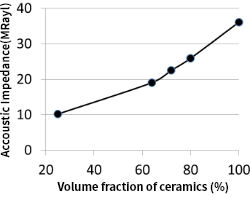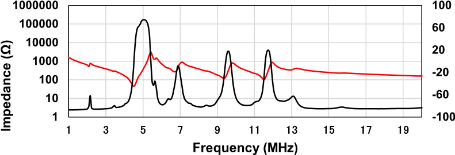Advantages of composite product
The four advantages of composite product are described below.
Advantage 01
Low acoustic impedance
Composite structure enables to reduce the acoustic impedance (AI) by varying the volume fraction of ceramics.
The efficiency of propagating acoustic waves to the subject substance such as water is improved by reducing the acoustic impedance.Therefore, a reduction in the number of acoustic matching layers can be achieved in case of multiple matching layers product.

Changes in acoustic impedance by volume fraction of piezoelectric ceramics
When acoustic waves are propagated from a conventional piezoelectric ceramics (AI: 36) to water (AI: 1.5),
Acoustic wave propagation efficiency is low owing to the high reflection at the interface

When acoustic waves are propagated from a piezoelectric ceramic composite (AI: 10) to water (AI: 1.5),
Acoustic wave propagation efficiency is higher as the reflection at the interface is reduced

Advantage 02
Improvement in transmission/reception sensitivity
Transmission sensitivity d33 and reception sensitivity g33 can be calculated using the following formulae.
g33 increases, and the sensitivity is improved when the PZT volume ratio is reduced by the composite structure.
In addition, wide bandwidth can be achieved as the electromechanical coupling coefficient is improved.
Transmission sensitivity d33:d33 = k33 x √(ε33T×s33E)
Reception sensitivity g33:g33 = d33/ε33T
By using composite product
-
The transmission sensitivity d33 remains nearly constant.
-
Reception sensitivity g33 is improved owing to the reduction in εr.
The sensitivity for transmission and reception improves.

Advantage 03
Suppression of spurious vibration that causes noise
Vibration in the lateral direction is suppressed by a resin between the piezoelectric ceramics; therefore, the noise is curbed.
*Shape:2×0.3×0.2(mm)

Vibrations in the directions of length, width, and thickness, overlap with one another and cause noise.


Vibration mainly occurs in the thickness direction.

Advantage 04
Mechanical flexibility
Material flexibility by composite with resin enables bending.

